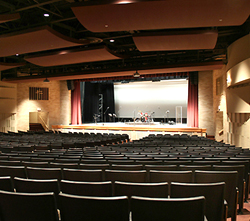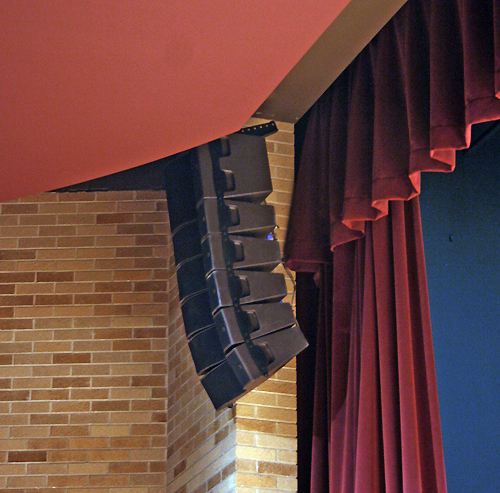
The addition of the clouds and the catwalk caused some concerns with respect to location/placement of the new house loudspeakers.
However, with the seating area extending only about 70 feet to the back, the team explored the possibility that highly compact left/right line arrays of a specific size, scale and location might be able to provide complete coverage, without the need for any loudspeakers on delay to foster total coverage to the rear of the listening area.
“The concern was to be able to ‘shoot’ sound under the catwalk and still hit the back row while not ‘toasting’ everyone in the front quarter or so of the listening area,” VandeHoef explains.
Based upon previous success in projects of this type, the team focused on L-Acoustics KIVA line array modules, and after building a model of the coverage area with the L-Acoustics Soundvision modeling program, it was determined that they could do the trick.
While these premium loudspeakers stretched the tight budget, it was determined to be a worthwhile trade-off.
Each of the two main arrays, flown to the left and right of the stage, include five KIVA elements that have two 6.5-inch drivers in a bass-reflex tuned enclosure and a 1.5-inch diaphragm compression driver coupled to a DOSC waveguide for high-frequency reproduction. A V-shaped coplanar transducer configuration generates a symmetric horizontal coverage of 100 degrees.
Both arrays here are topped by a single KILO module that extends response down to 50 Hz.
“By skimming the underside of the catwalk and increasing the arc of the arrays, we’re able to just hit the back seats without having a ‘shadow’ created by the catwalk cloud,” Zandstra says. “An exaggerated array arc (KIVA provides up to 15 degrees of inter-element vertical flexibility) further helps us attain solid coverage to the front row.”

Four L-Acoustics SB115 dual-15-inch subwoofers add extra low-end punch, mounted beneath the front stage. All loudspeakers are driven by L-Acoustics LA4 amplifiers/processors located in the adjacent audio equipment room, joined by BSS Soundweb London digital signal processor providing overall system processing.
Also helping keep the project on the right budget track was the decision to go with a very flexible Roland Systems Group mixing and routing approach for house, monitors and recording. Again, the project matrix proved a helpful start in defining options, with the team then checking into specifics and feature sets matched to the client’s objectives.
“As we delved into mixing consoles, we also needed to take a hard look at what the infrastructure for inputs, outputs and recording splits would look like,” VandeHoef explains. David Mosterd, the school’s theatre co-director, was very much in favor of a separate recording console because all chapel services are recorded, and the desire to have an in-house “mini studio”—a split of the inputs—was not optional.
Further, he sought something that would work well as a teaching tool because students primarily run the auditorium. “With so many hands on the board and the stage being set-up and torn down on a daily basis, we needed something that was simple, flexible, rugged and reliable,” he adds.
